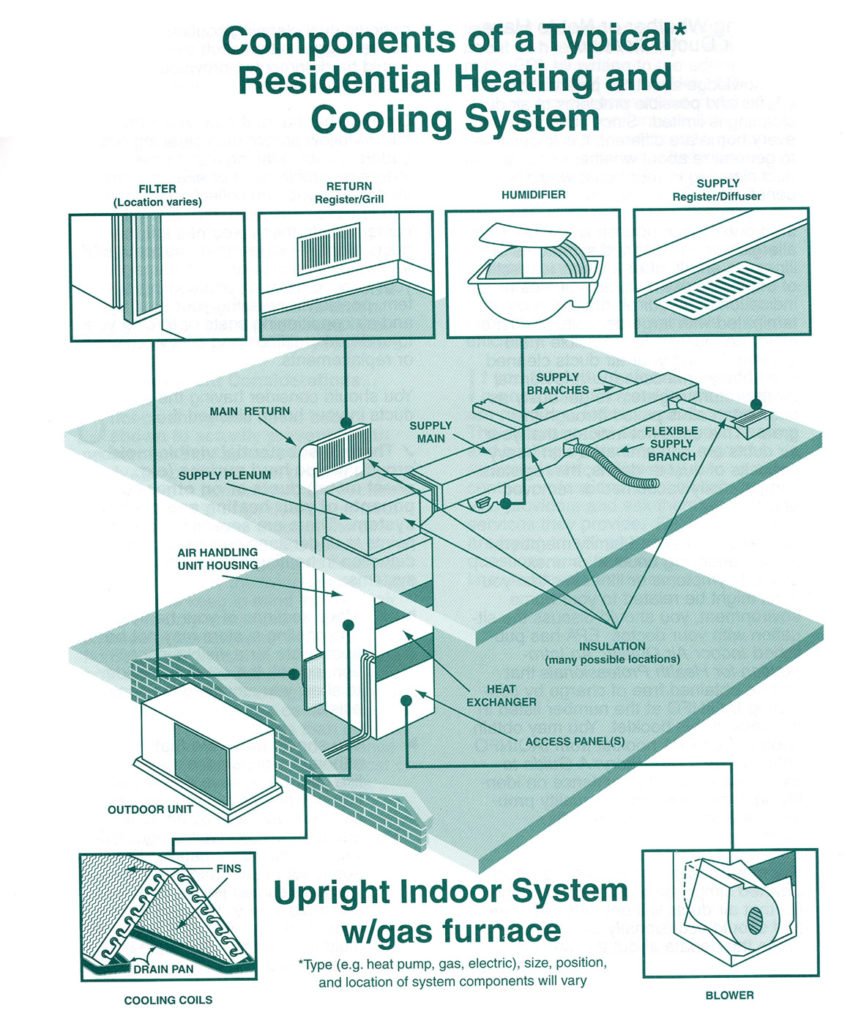Duct Cleaning

Duct cleaning generally refers to the cleaning of various heating and cooling system components of forced air systems, including the supply and return air ducts and registers, grilles and diffusers, heat exchangers heating and cooling coils, condensate drain pans (drip pans), fan motor and fan housing, and the air handling unit housing (See diagram).
If not properly installed, maintained, and operated, these components may become contaminated with particles of dust, pollen or other debris. If moisture is present, the potential for microbiological growth (e.g., mold) is increased and spores from such growth may be released into the home’s living space. Some of these contaminants may cause allergic reactions or other symptoms in people if they are exposed to them.
We use specialized tools to dislodge dirt and other debris in ducts, then vacuum them out with a high-powered vacuum cleaner.
You should consider having the air ducts in your home cleaned if:
- There is substantial visible mold growth inside hard surface (e.g., sheet metal) ducts or on other components of your system.
- Ducts are clogged with excessive amounts of dust and debris and/or particles are actually released into the home from your supply registers.
- Ducts are infested with vermin, e.g. (rodents or insects); or
If any of the conditions identified above exists, it usually suggests one or more underlying causes. Prior to any cleaning, retrofitting, or replacing of your ducts, the cause or causes must be corrected or else the problem will likely recur.
Some research suggests that cleaning heating and cooling system components (e.g., cooling coils, fans and heat exchangers) may improve the efficiency of your system, resulting in a longer operating life, as well as some energy and maintenance cost savings.
How to Prevent Duct Contamination
Whether or not you decide to have the air ducts in your home cleaned, committing to a good preventive maintenance program is essential to minimize duct contamination.
To prevent dirt from entering the system:
- Use the highest efficiency air filter recommended by the manufacturer of your system.
- Change filters regularly.
- If your filters become clogged, change them more frequently.
- Be sure you do not have any missing filters and that air cannot bypass filters through gaps around the filter holder.
- When having your heating and cooling system maintained or checked for other reasons, be sure to ask the service provider to clean cooling coils and drain pans.
- During construction/renovation work that produces dust in your home, seal off supply and return registers and do not operate the heating and cooling system until after cleaning up the dust.
- Remove dust and vacuum your home regularly. (Use a high efficiency vacuum (HEPA) cleaner or the highest efficiency filter bags your vacuum cleaner can take. Vacuuming can increase the amount of dust in the air during and after vacuuming as well as in your ducts).
- If your heating system includes in-duct humidification equipment, be sure to operate and maintain the humidifier strictly as recommended by the manufacturer.
To prevent ducts from becoming wet:
Moisture should not be present in ducts. Controlling moisture is the most effective way to prevent biological growth in air ducts.
Moisture can enter the duct system through leaks or if the system has been improperly installed or serviced. Research suggests that condensation on or near cooling coils of air conditioning units is a major factor in moisture contamination of the system. The presence of condensation or high relative humidity is an important indicator of the potential for mold growth on any type of duct. Controlling moisture can often be difficult, but here are some steps you can take:
- Promptly and properly repair any leaks or water damage.
- Pay particular attention to cooling coils, which are designed to remove water from the air and can be a major source of moisture contamination of the system that can lead to mold growth. Make sure the condensate pan drains properly. The presence of substantial standing water and/or debris indicates a problem requiring immediate attention. Check any insulation near cooling coils for wet spots.
- Make sure ducts are properly sealed and insulated in all non-air-conditioned spaces (e.g., attics and crawl spaces). This will help to prevent moisture due to condensation from entering the system and is important to make the system work as intended. To prevent water condensation, the heating and cooling system must be properly insulated.
- If you are replacing your air conditioning system, make sure that the unit is the proper size for your needs and that all ducts are sealed at the joints. A unit that is too big will cycle on and off frequently, resulting in poor moisture removal, particularly in areas with high humidity. Also make sure that your new system is designed to manage condensation effectively.
Source: U.S. Environmental Protection Agency – Indoor Air Quality Division
Make An Appointment
Fill out the form below, click submit and then we’ll call you to schedule a convenient time. Or you can call us 24/7 at (941) 758-2323.